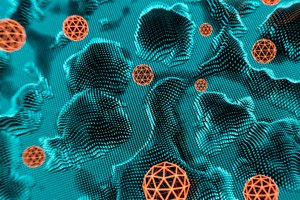
All iLive content is medically reviewed or fact checked to ensure as much factual accuracy as possible.
We have strict sourcing guidelines and only link to reputable media sites, academic research institutions and, whenever possible, medically peer reviewed studies. Note that the numbers in parentheses ([1], [2], etc.) are clickable links to these studies.
If you feel that any of our content is inaccurate, out-of-date, or otherwise questionable, please select it and press Ctrl + Enter.
Nanoparticle coating improves delivery of anticancer drugs and reduces side effects
Last reviewed: 02.07.2025
 ">
">A recent study from the University of Mississippi suggests that a "spoonful of sugar" may actually help drugs work more effectively while reducing the harmful side effects of cancer treatments.
Instead of a literal spoonful of sugar, the researchers used glycopolymers — polymers made from natural sugars like glucose — to coat nanoparticles that deliver cancer drugs directly to tumors. They found that the glycopolymers prevented proteins from sticking to the nanoparticles, reducing the body’s immune response to the treatment.
As a result, the body responded better to therapy.
"The main problem is that cancer drugs are incredibly toxic," said Thomas Werfel, an associate professor of biomedical engineering.
"The therapeutic window of these drugs is very narrow: the dose at which they are effective is almost the same as the dose at which they become toxic. And once the dose is sufficient to kill the tumor, it also causes toxicity and numerous side effects that we are trying to avoid.
Why does this happen? Because only a small portion of the drug reaches the tumor — in most cases, less than 1%; more than 99% goes to other parts of the body."
Thomas Werfel, Associate Professor of Biomedical Engineering, University of Mississippi
This leakage of toxic drugs into other parts of the body can cause serious conditions such as leukemia, allergic reactions, and even the development of new cancers. However, if more of the drug reaches the tumor, the side effects can be reduced.
Advantages of glycopolymers
Werfel and Kenneth Hulugalla, a biomedical engineering graduate student from Kandy, Sri Lanka, published their findings in the journal ACS Nano in October.
Nanoparticles — particles less than one-thousandth the width of a human hair — have proven effective in treating cancer by delivering drugs directly to tumors. However, proteins, including those that trigger an immune response, tend to clump around the nanoparticles, causing the body to label the treatment as foreign.
This immune resistance reduces the effectiveness of the drug.
"For the past 30 years, polyethylene glycol (PEG) has been the gold standard for protecting these particles from the immune response," Hulugalla said.
However, PEG-based coatings lose their effectiveness after the first use: the immune system quickly begins to recognize the drug as foreign, which prevents it from entering the tumor.
Glycopolymers, on the contrary, do not have this disadvantage.
"Our results show that glycopolymer-coated nanoparticles significantly reduce unwanted immune responses while dramatically improving drug delivery in both cell and animal models. This research could be an important step toward more effective cancer treatments."
Animal studies
Werfel and Hulugalla tested the glycopolymer-coated nanoparticles in mice with breast cancer and found that more nanoparticles reached tumors compared to PEG-based particles. The next step in their research will be to load these nanoparticles with drugs and test their effectiveness against cancer.
"In the long term, we want to not only study this phenomenon from a protective perspective, but also work on actively targeting nanoparticles to tumors," Werfel said.
“We are already seeing that glycopolymers stimulate the immune system less, the particles stay in the body longer and reach the tumor better. This is great.
But the next step is to look at how we can target tumors. What biological markers can we use to get more particles or drugs to accumulate in the tumor? These are the questions that are at the forefront of our attention right now."
The study was published in ACS Nano.
